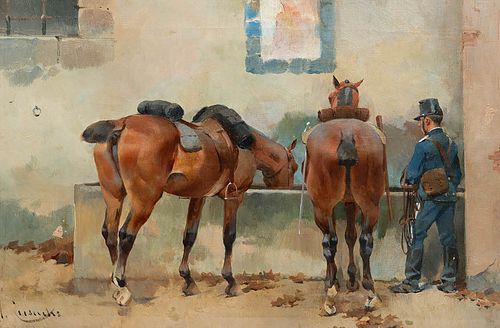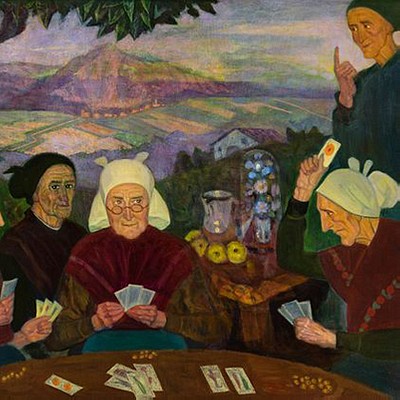JOSÉ CUSACHS Y CUSACHS (Montpellier, France, 1851 - Barcelona, 1908). "Giving water to the horses". Oil on canvas.
Lot 25
About Seller
Setdart Auction House
Carrer Aragó 346
Barcelona
Spain
Setdart Subastas was born in 2004 and is currently the first online art auction in Spain with solidity, prestige and reliability guaranteed by our more than 60,000 users. Setdart has a young, dynamic and enterprising team ready to successfully manage the purchase and sale of art works through custom...Read more
Estimate:
EUR€7,000 - EUR€8,000
$7,291.67 - $8,333.33
Absentee vs Live bid
Two ways to bid:
- Leave a max absentee bid and the platform will bid on your behalf up to your maximum bid during the live auction.
- Bid live during the auction and your bids will be submitted real-time to the auctioneer.
Bid Increments
| Price | Bid Increment |
|---|---|
| EUR€0 | EUR€10 |
| EUR€200 | EUR€25 |
| EUR€500 | EUR€50 |
| EUR€1,000 | EUR€100 |
| EUR€3,000 | EUR€200 |
| EUR€5,000 | EUR€500 |
| EUR€10,000 | EUR€1,000 |
| EUR€20,000 | EUR€2,000 |
| EUR€50,000 | EUR€5,000 |
About Auction
By Setdart Auction House
Dec 14, 2021
Set Reminder
2021-12-14 08:00:00
2021-12-14 08:00:00
America/New_York
Bidsquare
Bidsquare : 19th & 20th Century Fine Art
https://www.bidsquare.com/auctions/setdart-auction-house/19th-20th-century-fine-art-7992
Gaudi, Sorolla, Torres Garcia, Maclet, TSUGUHARU FOUJITA, Benjamin Palencia Setdart Auction House sofia@setdart.com
Gaudi, Sorolla, Torres Garcia, Maclet, TSUGUHARU FOUJITA, Benjamin Palencia Setdart Auction House sofia@setdart.com
- Lot Description
JOSÉ CUSACHS Y CUSACHS (Montpellier, France, 1851 - Barcelona, 1908). "Giving water to the horses". Oil on canvas. Signed in the lower left corner. Measurements: 30 x 50 cm; 56 x 70 cm (frame). It is also habitual in the best works of Cusachs the careful work of the landscape, with a subtle and fluid brushstroke that reflects with the fidelity of a watercolor the light and the atmosphere of the scene. José Cusachs was accidentally born in France, as his parents were traveling there, but his art and his life were always linked to two places: Barcelona and Mataró. In 1865, after passing a competitive examination, he entered the Artillery Academy to pursue a military career. However, in 1882, after a brilliant career that led him to be Captain of the Army for war merits, he asked for retirement to devote himself to painting. Trained in Barcelona under the direction of Simón Gómez, he completed his artistic studies with a stay in Paris, in the studio of Édouard Détaille, one of the greatest experts in military themes, a genre that would be Cusachs' favorite. Within the military themes, this artist was especially inclined to cavalry, due to his passion for horses. In 1880 he settled in Barcelona and began an extensive production of military studies, which were reproduced in the work of F. Barado entitled "La vida militar en España" (Military life in Spain). Previously, before leaving the Army, he had worked as a caricaturist and chronicler of a Spain immersed in a maelstrom of political events, in which he was immersed due to his military condition. It was precisely the success of these early works that prompted him to finally abandon his previous career to focus on art. During these years he would make his work known through individual exhibitions, such as the ones he held regularly from 1884 at the Sala Parés in Barcelona, always obtaining great success in sales and critics. In 1890 he was already a regular exhibitor at the gallery, where he showed new works every week. The bond between Cusachs and the Sala Parés was so deep, in fact, that after the painter's death the gallery fell into a period of absolute decadence. Cusachs also participated in official competitions; in 1887 he obtained notable recognition at the National Exhibition of Fine Arts in Madrid with three paintings, one of which was acquired by the regent María Cristina ("En el campo de maniobras"). In 1891 he participated in the Berlin Exhibition and won the Gold Medal for his work "Maneuvers of division". Cusachs also stood out as a famous military portraitist, and painted, among others, General Prim, King Alfonso XIII in military uniform and Mexican President Profirio Díaz. Other notable works by his hand are "The Flight to Egypt" (1904) from the Monastery of Montserrat, one of his few religious canvases, and "Abnegation" and "Distant Thought". Stylistically, Cusachs was a man open to innovation, although his work was always filtered through the filter of evaluation, study and meditation. Thus, he adopted those aspects he considered of value, and discarded the rest. The bulk of his work is collected in the Museum of Modern Art in Madrid and the National Art Museum of Catalonia, as well as other centers such as the Museum of Montserrat, the National Museum of History, the Captaincy General of Valencia, the Artillery Headquarters of Valladolid, the Gallery of Illustrious Captains of the City of Barcelona and prominent private collections, such as the Santiago Gramunt.
- Shipping Info
-
In-house shipping available. Please inquire at admin@setdart.com.
-
- Buyer's Premium



 EUR
EUR CAD
CAD AUD
AUD GBP
GBP MXN
MXN HKD
HKD CNY
CNY MYR
MYR SEK
SEK SGD
SGD CHF
CHF THB
THB
















